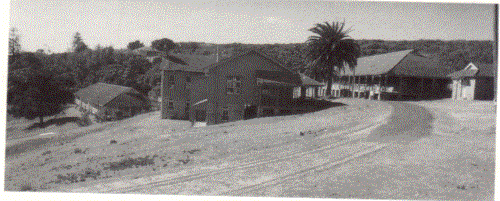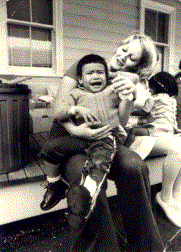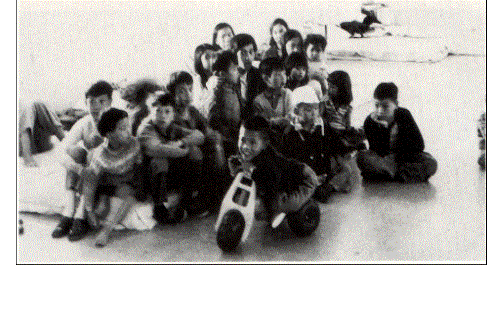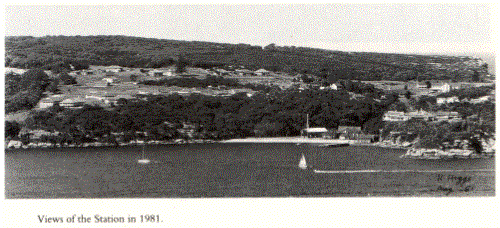April-May 1975 – Kindly shared by Author and Quarantine station volunteer, Chris Sturt
I was living in the Manly Nurses Club at the end of the Vietnam War in 1975. I wasn’t a nurse, but it was a bed sit type situation which suited me well since I had just returned from England. One of my fellow residents was a nurse at the Far West Childrens Home in Manly and she often called me into work as a ‘volunteer’ to help feed the babies.
It was the Far West Childrens Home, along with the local hospitals that received the call for nurses to ‘come and help at North Head’. The Quarantine Station was asked to prove emergency accommodation following the Australian Government’s decision to rescue as many as possible of the children housed in Vietnamese orphanages before the fall of Saigon. A senior official from the Australian Department of Health flew to Bangkok to pick up the children: 74 were taken to Melbourne and 215 to Sydney.
On arrival in Sydney, 100 children were admitted to the Royal Alexandra Hospital for Children and the rest were taken to the Quarantine Station at North Head, Manly.

Quarantine Station, North Head, Manly *
Two former hospital wards were converted into a combined dormitory, eating area and medical examination area. Twenty nurses cared for the children on a shift basis, with assistance from the Station’s staff and volunteers who included Vietnamese students. The orphans remained there for about two weeks while homes were found for them. I remember that several adoption agencies were represented there – church, government, and non-government.
I was working at the National Bank Computer Center but willingly took a few days off to go and give a hand – once there I was hooked, and did not leave until the last child did! Luckily, I had an understanding boss who not only gave me his blessing, but also the National Bank driver (Barry) who arrived at the gates daily, the bank car loaded with toys, clothes and ‘treats’ (lots of lollies) donated by my work colleagues.
The children had very little with them in the way of possessions or clothes and for the first couple of days, there were very few adults who could speak their language At first, the children could best be described as ‘cagey’ and I often wondered if any of them understood what was going on. – it was terrifying for many of them and I did not need to speak their language to understand the looks on their faces (or they mine!).
The first few days were taken up with beds (lots of mattresses on the floor), baths, clothes and inoculations. Many of the children knew each other well and the older ones looked after the smaller ones better than we could hope to do. In particular, there was a group of teenage boys who were the wise ones and a lot of the unofficial information on the children came from them. We soon learned to take their advice when we were doing things wrong! They were too old for adoption (their decision I think) and I am not sure now, but I think they were all given housing in a cottage somewhere – maybe even South Australia.
I remember one of the first dinners we had. There was so much food and it never occurred to the carers to try and limit anybody’s intake! Oh the diarrhoea that followed the first meal or two! (Where are the spare clothes that came?) We were supposed to be looking after them and we made most of them sick! When I was tucking some of the children up in bed that night, rice was falling out of pockets left, right and center and I couldn’t hope to make them understand that there was no need to hoard food – had they been so hungry before or were they preparing themselves for the worst?
There were lots of tears those first few days and lots of giggles too (no language needed for that). It’s been a long time and I should have more memories than I do. One little girl never forgave me for holding her arm while she was inoculated whilst another small boy decided to adopt me and never left my side until his new parents collected him. He was a Buddhist and we nicknamed him ‘sparrow’ because his legs had an unusual way of bending almost backwards from the knees (he didn’t talk much to us or the other children, and I don’t think the other children knew him very well), I think he may be the boy on the bike in the photo below. A Buddhist couple adopted him – I think they were Doctors.

This picture of myself and a little girl taken right after her ‘needles’ appeared on the front page of a newspaper (? Sydney Morning Herald) – now identified as Kim Chi.
At first I visited the station daily, doing what I could. I ended up sleeping there(after a typhoid scare) and my main task was to help in the ‘boys ward’ – a long thin room with a bedroom and bathroom at the end where the nurses slept. The boys nicknamed me “Mama Lei” (I don’t know if I have spelt this correctly – for all I know it could have been an insult but I think it meant American lady).
One night, after the kids were all in bed and the nurse had gone for her break, I was sitting on the inside verandah having a nice quiet smoke – a much MUCH too quiet smoke! There was not a sound from the ward! I crept in to have a look and the ward was empty! Not a soul – from the 3-4 year olds to the 14-15 year olds! All gone! How could I have lost so many? Had they run away? Were they trying to get home? I was terrified…….I ran all around the building (the middle one top picture) – down the sloping lawn to the cliff top – not a sign. I hurried back up the hill to get some help and entered the dormitory by the back door, near the nurses quarters – and heard the giggles………I opened the bedroom door…….nothing…….I opened the bathroom door and was deafened by the shout of “HAPPY NEW YEAR” by my charges, covering every square inch of the tiny room, all squashed in, standing on the toilet and even hanging from the cistern! To this day, I have never heard so many children collapse in giggles at one time!

Some of the children accommodated at North Head including Hoa Stone, now an author of the autobiography, “Heart of Stone” *see newsletter for how to purchase.
Once the children had settled down, mischief became the norm. A foreman at the Station * tells the story of a blind child who quickly learned how to lock the doors of the ward, causing occasional problems as well as amusement. He too was impressed with the way in which the children supported each other and how if one child cried another would hold it’s hand.
I’ve written these memories after stumbling across the AVI (Adopted Vietnamese International) website when I was looking for the end of a story about young girls in the UK, sold by their father as ‘brides’ in the Yemen. I immediately sent the photo of the young girl and I to the site thinking that she might see it. Indigo Williams suggested that I jot down my memories in case someone could connect with them – and here they are.

Once I started, I wanted to paint as full a picture as I could. in case any of the ‘orphans’ could use the information in their personal searches about their past. I have used a book (*) to help overcome my shortfalls and I hope the author will not mind. (“In Quarantine – A history of Sydney’s Quarantine Station 1828-1984” by Jean Duncan Foley).
For those orphans who are now looking for answers:
- I recall a couple of nuns as being the people responsible for providing the ‘official’ details to our Government – whether or not these nuns were in the Station with us, I can’t really remember– but I seem to think that they were.
- As time passed and interpreters and carers established rapport and trust with the children, there were stories circulating that some of the children weren’t orphans at all, but had been left temporarily with the nuns, either for short term care or to get them out of Saigon.
- The church adoption agencies involved included Catholic and Anglican.
- The government agencies involved included the Public Health Division, Australian Dept. of Health and the NSW Government.
- The Quarantine Station is now a part of the National Parks and Wildlife Service.
- I hope you find what you are looking for.